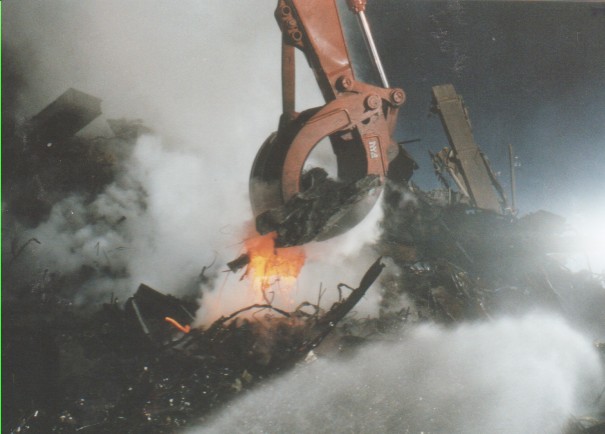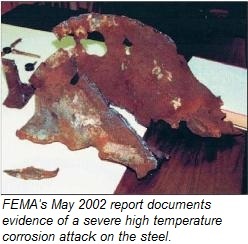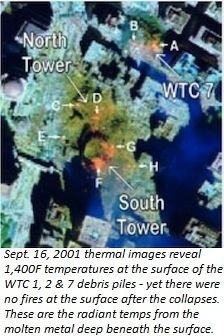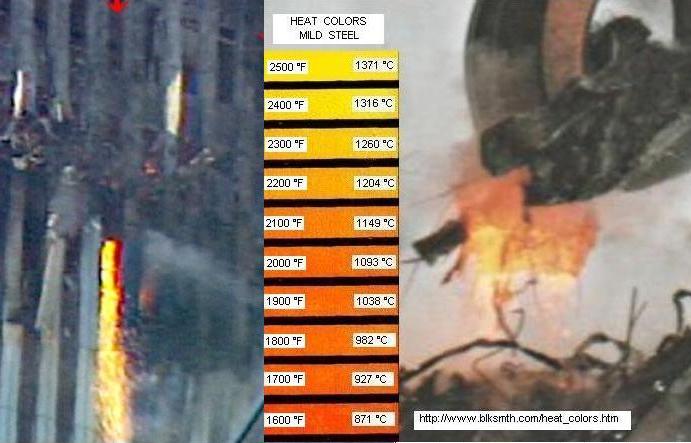if your going to quote wiki
Your WIKI argument is despicable. What of the references there? Have you compared the references with WIKI's summary?
If your really going to argue that the potential energy is somehow responsible for glowing hot steel
I have argued it. You are not addressing my argument properly already.
months after the collapse
Must someone teach you about thermal insulation?
I'm just not going to be able to take you seriously
I had noticed that already. I'm still waiting for you to seriously address my thinking.
That's not serious.
you'll come to understand that its not an argument, its a discussion.
Which I'm still awaiting the beginning of.
lacking any real investigation worthy of scientific scrutiny
A discussion which hasn't yet begun exhibits these properties.
I guess we'll all just have to go with the obvious.
That's not science, which is the study of the
not obvious.
fires burning at no more than 825°C do not produce temps
Have you read my posts? Hasn't this been covered?
An education in software may be insufficient by itself for this task.
Perhaps though this novel theory should have a definitive thread, instead of cropping up again and again in other threads.
It crops up again and again because no-one accepts my explanation. That doesn't invalidate it. The truth continues in spite of all.
Potential energy isn't some imaginary single force that can concentrate itself on any given spot in a building it chooses. Its unique to each individual piece of a structure based on its position in the building. As each piece becomes detached through whatever mechanism that piece still has its potential energy
Momentarily. It then exchanges potential energy for kinetic energy through gravitational acceleration.
as it descends other parameters come into play and kinetic energy comes into play
Nope. The exchange begins with
the loss of mechanical connection.
it will shed that through a number of different means, some energy might go into bending that piece, which will also release a bit of heat as well. Example would be swaging a pipe, the pipe ends up a little hotter due to the internal friction of the bending process. The heat is proportional to the energy used to bend the pipe. In the case of a falling object the energy is no greater that the potential energy of that individual piece.
Yep. All of that was bound to happen on the way down. But I can see you're missing my point entirely.
I think Jazzy is confused as to the difference between potential energy and kinetic energy.
No. You are. You have just demonstrated this.
The building would not have collapsed due to potential energy
The building was designed to resist its gravitational load, wind forces and possibly earthquake forces. It wasn't designed to resist
energy.
the structure was build to resist its own collapse by a factor of many times
No. It was designed to resist its
loads by a factor of ten.
once started in motion its kinetic energy may have, and most assuredly did have, some factor in the manor of that collapse.
You don't say?
Universally any individual piece or group of pieces will follow the path of least resistance towards equilibrium.
Which is? I'll tell you: a parabola comprised of its lateral velocity and its downward acceleration of G, superimposed on which might be a rotational component due to the manner of detachment. Once it is detached, of course.
I question if that is what we saw in the collapse of both the towers or WTC 7
Don't include me in your perception, please.
Jazzy said that there was enough potential energy in the towers to bring 840 tons of steel to about 1500°C, which I'll take on face value.
You shouldn't. You should calculate it, in order
to be sure it is really there. Otherwise you continue to slip as you have done so far. Hilltops are reached by climbing, not falling.
But his concept that all that energy could end up in some few single pieces is wildly flawed.
That isn't my concept. Is this your straw man?
My concept is that
some of the kinetic energy ended up right at the bottom of the wreckage. It is only required that
some energy reaches there.
It would have been fairly evenly distributed throughout the entire rubble pile as more and more pieces came to a crashing halt, bending, rubbing against one another, compressing the pile are all forms of energy dispersal that would have distributed the available heat energy of any single piece involved in deformation of whatever type during the fall, relatively evenly throughout the rubble.
That doesn't take into account the fact that steel is three times denser than concrete and eight times denser than wallboard. Steel has ten times the strength of concrete and a hundred times that of wall boarding.
In what order would you expect to find steel, concrete and wall board in such a wreckage pit? If you don't say the lightest material at the surface, the denser material further down, and the densest material at the bottom, you
must be kidding yourself.
If you drop steelwork into this rubble from an eighth of a mile up, it isn't going to linger at the surface unless it lands absolutely flat. Even so, if it lands flat, it will impart its momentum to the rubble. Otherwise it will penetrate the rubble, parting its contents, until it reaches ground zero, which will stop it.
Or it will hit steel, which brings it to an elastic stop. The piece struck by it hits ground zero for a second time, with the kinetic energy it has just received. And so on.
The whole point of this is that ground zero
is being struck by the same material over and over again, as half a million tons of material arrive from above at around 120 mph, and steel collides with steel.
But in the end the total heat energy available would under no circumstances concentrate itself on one small group of individual pieces at some specific location within the rubble pile.
The
total heat energy? Some
specific location? LOL.
There was excessive heat evident in the photographic evidence, but we don't know where it came from yet.
LOL. That may well be because you find yourself unable to
even mention Newton's Cradle, and its demonstration of kinetic energy transfer.
whatever energy is responsible must be a localized form of energy - its just not going to heat it fast enough
You are now arguing on my side for a moment. You didn't notice.
there is a case for the surrounding connections <snip> completely.
Completely off the point.
it takes more than just a simple office fire to do it
I entirely agree.
The kinetic energy must have partially gone into breaking almost all of the connections between beams
And the amount can be worked out by studying the actual downward acceleration and not insisting the building collapsed in free fall. I don't want you to force me to have to force-feed you with videos of free-falling pieces of tower falling past the more slowly falling tower. The towers fell at .7G and .64G respectively, and those figures reflect
the proportions of the kinetic energy being converted to destructive energies.
No opportunity exists for any excessive heat to build up due to a number of fractures because once fractured there is no mechanism to move that heat from one piece to another.
Is a straw man.
There may NOT be a mechanism for
heat transfer, but there IS a mechanism for
kinetic energy transfer called
impact or
collision. This energy may both
cause plastic deformation and generate heat, but the steel's
elastic kinetic energy is always handed on.
Ground zero is where the buck stops. Elastic kinetic energy reaching there must reflect back, even allowing for Mick's seismic ground deflection. It cannot return to the surface by the route it took to reach Gzero, because the process is dynamic.
The point is that KE freely travels through the steel until it meets Gzero, and can less freely return.
That puts "inexplicable" energy in an "inexplicable" place, right? And it isn't a temperature-dependent process, it's a
successive process, right? (Except for the upper limit, near melting, where the steel is
losing its elasticity).
What happens to
elastic KE when it reflects back? Well, effectively
it is a sound wave (traveling at five miles per second) and what happens is that it whacks around the internal faces of the steel until it becomes random molecular vibration, or
HEAT. Clang!
There must be some other explanation.
There is none that Occam would approve of.
This is "god of the gaps" argument. But
there is no gap from where I'm standing...climb up a little further and you will see...





